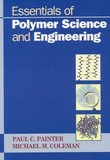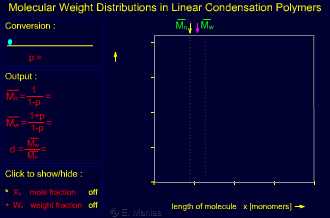 MatSE 443
MatSE 443 Introduction to the Materials Science of Polymers
Penn State University
 PC Painter and MM Coleman Essentials of Polymer Science (DEStech Publications) |
Chapter 5 (pgs. 113-120 only)
Concepts that you must know:- Definition of 'extend of reaction' (p), also as a probability.
- Statistics of Polycondensation: average molecular weights (Mn, Mw) as a function of the 'extend of reaction' (p), polydispersity as function of p
- Mole fraction & Weight fraction of x-mers in polycondensation
- Know how to apply simple Equations [e.g. eq.5.15 (also in Fig.5.9), eq. in Fig.5.10, and eq.5.17(typo)]. That is, given the p, or the concentrations (initial and concentration at p) of functional groups to calculate xn, xw, and polydispersity (xw/ xn).
- *Go through the derivations of xn(p) (pg. 115, eq.5.3), and xn(p,r) (pg. 116, eq.5.9)
- *Go through the derivation of the Mole fraction & Weight fraction (pg. 117-119)
The interactive module below is an Adobe Flash object (whose native support is deprecated); you will need a Flash Emulator extension for your browser: there are several available for free in your browser's extension/web store (we recommend the "Ruffle Flash Emulator" extension, also "Flash Player Emulator 2024", "Flash works Again" and "Flash Player Enabler" seem to be as good for this course's interactive modules).

- Start by showing one curve (mole/weight fraction) at a time and observe how each curve changes with p (move the slider). Plot both curves and compare their shapes and positions. (can you connect it back to the definitions of Mn and Mw from chapter 2?)
- Comment on how the values of Mw, Mn, and d depend on the "extend of the reaction" (p).
- Which molecule size has the largest mole fraction at any instant in the reaction (p)? Which molecule size has the largest weight fraction at any instant in the reaction (p)? Comment on the two!
